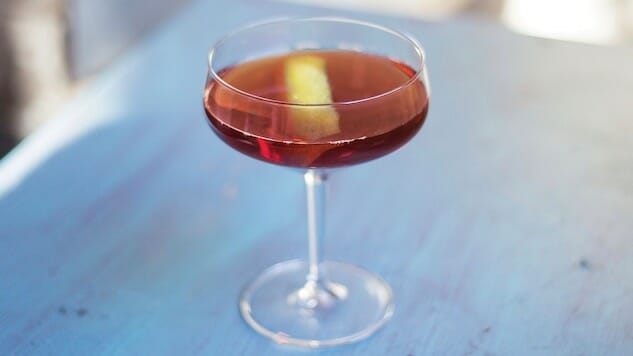Apple Brandy is the Unsung Hero of Winter Drinking
Photos via Copper and Kings
John Chapman was a certified weirdo: Swedenborgian missionary, barefoot tree hugger given to wearing flour sacks and tin pots, and a serious apple zealot. Because of him, settlers along the American frontier had a head start on one of the real homesteader necessities-alcohol. As much as there is truth in the image of “Johnny Appleseed” as a benevolent nature-worshipping pilgrim (he was also that), he was a businessman to the bone and there was a distinctly practical point to his sowing seed apples all over the frontier. Planting 50 trees was enough to entitle someone to stake a legal claim on a swath of land, so for a few apple seeds, Chapman could make himself into a real estate mogul, and people could buy tracts of land with cider orchards already started on them. It was a very smart business model.
Cider (and applejack, and apple brandy) were necessities on the frontier and all the way up until Prohibition, when the government dealt a near-death blow to cider and to apple diversity. In recent years, cideries have made a comeback, though in some regions the damage to heritage apples might be irreversible (where I live, the best heirloom apples happen to occupy space also suitable for Pinot grapes-most farmers cannot afford to keep their trees). Brandy and eau de vie remain smaller niches at this point, but they are out there, and worth seeking out.

Copper & Kings “Floodwall” aged apple brandy is a really nice draft pick if you’re looking for a new cold weather cocktail friend. The brandy is aged in barrels and casks previously used to hold Kentucky bourbon and Oloroso sherry, and it has a fairly pronounced “whiskey-ness” to it, though it definitely tastes like apples. Sub-notes include walnut, almond, toast, dates and butterscotch. The finish is a little feisty (“hot” is probably a fair descriptor) but it calms down if you let it sit and open up for a bit. I recently cracked a bottle of this when I was in the mood for something warm and homey and I have to say it makes a very nice toddy. You can combine it with black or oolong tea, or warmed cider, or just hot water—add a little honey, a cinnamon stick, and if you want to get kooky, a couple of cloves or a bit of star anise or cardamom or allspice (a little lemon or mandarin juice is also a welcome component). It’s wintry, soothing, a nice digestive (or, if you’re liberal with the sweet elements, it can easily become a dessert) and while you might associate toddies with recovering from the flu or fending off a sore throat, believe me when I say they only taste better if you’re not actually sick.
-

-

-

-

-

-

-

-

-

-

-

-

-

-

-

-

-

-

-

-

-

-

-

-

-

-

-

-

-

-

-

-

-

-

-

-

-

-

-

-








































